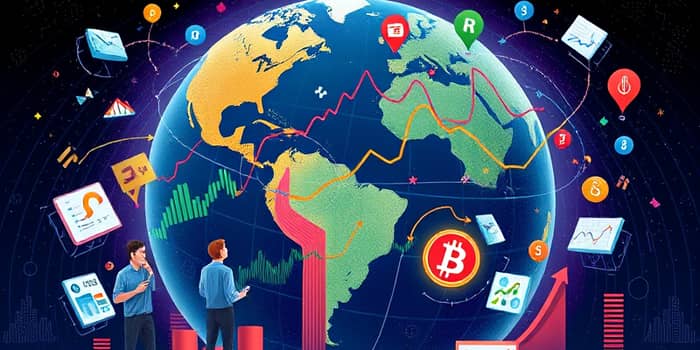In the modern age, financial markets are deeply intertwined with politics, policies, and global developments. Investors today navigate volatile and uncertain market conditions as world events shape economic outcomes and asset values.
This article explores recent economic indicators, major global events, and practical strategies to help you align your portfolio with the evolving landscape.
Global Economic Overview (2025–2026)
Leading institutions have updated forecasts for growth, inflation, and recovery trends. Understanding these projections is essential for aligning investment strategies with macroeconomic shifts.
- Growth projections vary significantly across sources: IMF sees 3.0% in 2025 and 3.1% in 2026, OECD forecasts 2.9% both years, and the World Bank predicts a modest 2.3% in 2025.
- Inflation is expected to ease globally, with IMF citing a drop to 4.2% in 2025 and 3.6% in 2026, yet remaining elevated in key advanced economies.
- Commodity prices may decline, driven by an anticipated 10% drop in overall commodities in 2025, led by lower energy costs.
- The recovery remains uneven across regions and sectors, with some advanced economies cooling while parts of Asia maintain moderate momentum.
Key World Events Shaping the Global Economy
Events such as tariff adjustments, geopolitical conflicts, and commodity supply shifts exert direct pressure on global growth and asset valuations.
Trade Policy and Tariffs
Recent tariff escalations have altered trade flows and price levels. In the United States, duties now reach 50% on certain Brazilian goods and 35% on products from Canada outside the USMCA framework. Pending negotiations also threaten additional 25% levies on Mexican exports.
These measures drive inflation and trade cost increases in imposing countries while inflicting demand shocks on exporters, potentially dampening growth in affected regions.
Geopolitical Tensions and Regional Conflicts
Ongoing rivalries among major powers and regional hotspots generate significant downside risks for growth. Sanctions, military buildups, and conflicts—in parts of Eastern Europe, the Middle East, and the Asia-Pacific—can disrupt supply chains and trigger sudden commodity price swings.
Investors should monitor political developments carefully, as flare-ups may lead to abrupt shifts in risk sentiment and capital flows.
Commodity Price Trends
Commodity markets are responding to both demand forecasts and supply adjustments by producers. OPEC+’s decisions on oil output, combined with weaker consumption growth, signal lower energy prices ahead.
Base metals have seen partial rebounds from earlier declines, but overall momentum hinges on manufacturing activity and infrastructure spending in major economies.
Regional and Country-Specific Outlooks
Growth prospects diverge notably across key regions, requiring nuanced positioning for international portfolios.
Monetary policies diverge: the US holds rates steady, the Eurozone pursues easing, Japan gradually tightens, and emerging markets remain reactive. Such variation fuels currency volatility and cross-border investment complexities.
Major Risks and Uncertainties
Global economic outcomes face multiple threats that can undermine forecasts:
- Trade war escalation: additional tariffs and retaliation could stall expansion.
- Geopolitical flashpoints: new conflicts may trigger supply chain disruptions and market dislocations.
- Commodity shocks: sudden price spikes or collapses affect resource-dependent sectors and economies.
- Extreme climate events: floods, droughts, or fires damage infrastructure and disrupt production.
- Financial stress: negative shocks in credit markets could spread quickly in leveraged economies.
Given these uncertainties in global policy and markets, robust risk management is imperative.
Investment Implications and Sector Insights
Assets and industries respond differently to shifting global conditions.
Equities in defensive sectors—such as utilities and healthcare—tend to outperform during volatility, while exporters in high-tariff environments may face profit pressures. Technology firms still contend with supply chain constraints and regulatory changes, whereas financial companies react sensitively to interest rate expectations and credit availability.
Commodities and energy names may experience margin squeeze from lower prices, although downstream consumers could benefit from reduced input costs. Emerging market assets remain prone to currency swings and capital flow reversals, but selective exposure can capture attractive yields where fundamentals are strong.
Actionable Considerations for Investors
To navigate the complex global backdrop, consider these practical steps:
- Diversify portfolios across regions and asset classes to cushion against localized shocks.
- Monitor geopolitical developments and trade policy signals to anticipate market reactions.
- Employ hedging strategies—such as options or currency overlays—to manage volatility and currency risks.
- Seek thematic opportunities in sectors benefiting from policy easing or structural trends like renewable energy and digital infrastructure.
Staying informed and agile allows investors to adapt as global events unfold, balancing risk and return proactively.
Policy, Confidence, and Recovery Signals
Ultimately, restoring market confidence depends on policy clarity and global cooperation. Many experts call for predictable rules-based global trade frameworks and coordinated fiscal measures to support demand.
Financial conditions—shaped by interest rates, credit availability, and risk premiums—serve as the conduit through which external shocks reach portfolios. Remaining aware of central bank commentary and credit spreads can help investors anticipate turning points in economic cycles.
In an era of rapid change, adaptability, vigilant risk management, and strategic diversification remain the hallmarks of resilient investment approaches. By grounding decisions in sound economic analysis and keeping a close eye on world events, investors can better position themselves to navigate uncertainty and capture emerging opportunities.
References
- https://www.mckinsey.com/capabilities/strategy-and-corporate-finance/our-insights/global-economics-intelligence
- https://www.oecd.org/en/about/news/press-releases/2025/06/global-economic-outlook-shifts-as-trade-policy-uncertainty-weakens-growth.html
- https://www.spglobal.com/market-intelligence/en/news-insights/research/global-economic-outlook-july-2025
- https://www.imf.org/en/Publications/WEO/Issues/2025/07/29/world-economic-outlook-update-july-2025
- https://www.ey.com/en_us/insights/strategy/global-economic-outlook
- https://www.conference-board.org/topics/us-leading-indicators/
- https://www.deloitte.com/us/en/insights/topics/economy/us-economic-forecast/united-states-outlook-analysis.html










